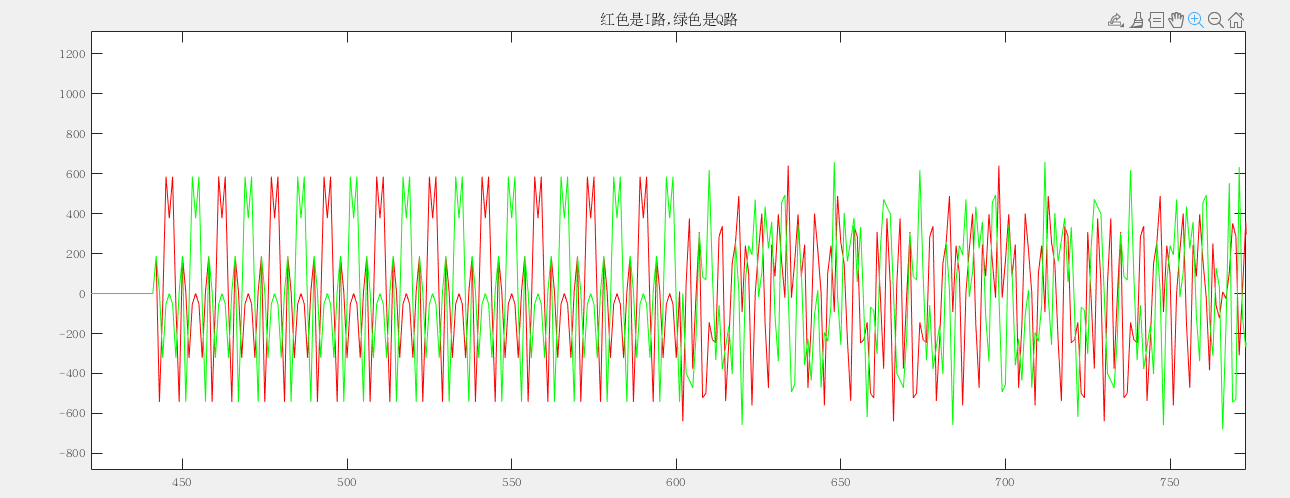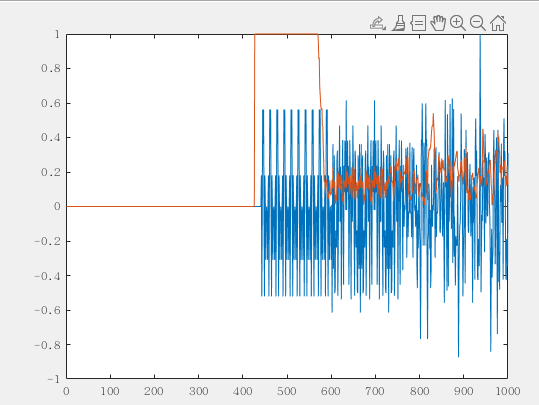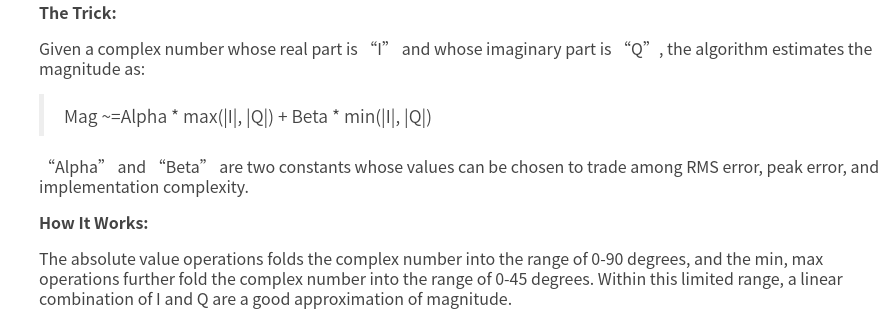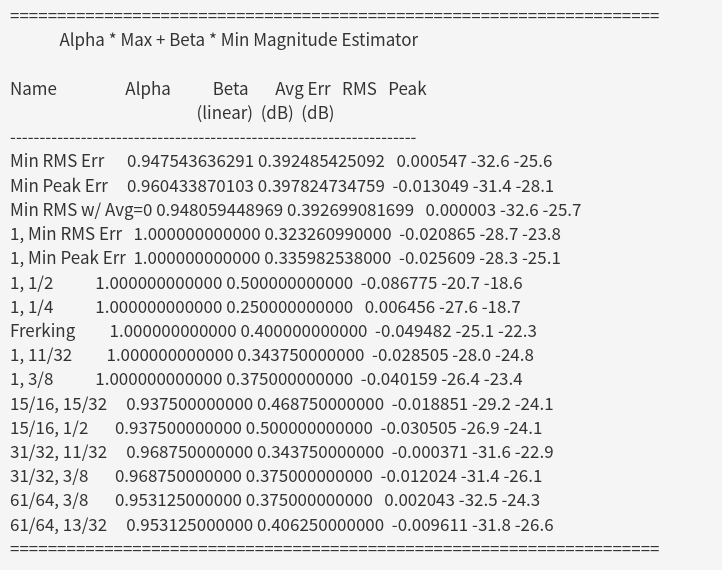1. 前言
在前面实现了802.11a的发送数据包的生成,从而完成了802.11a的发送数据通路。在上面实现了数据的加扰,卷积编码,交织,OFDM星座图映射,IFFT的转换和添加循环前缀,添加前导码LTS,STS等操作。
相较于802.11a的发送数据链路,接受数据链路的难度相较于发送链路会大很多,里面涉及了许多同步的算法的设置,频偏的校正等操作。
从这篇博客开始,我将会记录在学习802.11a数据解调的过程中所学习到的东西。
2. 短训练序列的检测原理
在一个802.11a的数据帧当中,首先是10个短训练序列,每个短训练序列的长度是0.8us,在解调802.11a的帧数据的时候,可以使用短训练序列来进行包检测。
在前面实现OFDM发送机的时候,我们可以知道,这10个短训练序列是重复的,因此在接收端可以对接受到的信号进行相关来检测相关峰,因为当短训练序列正好对上的时候,根据短训练序列的特性,相关的结果将呈现一个较大的值。
一个短训练序列的周期是0.8us,在20M采样率的情况下,一个段训练序列需要16个采样周期。
其中 $\overline{s[i+16]}$ 是之后16个采样点的共轭, $\overline{s[i]}$ 是当前采样点的共轭。在进行相关的时候,到了段训练序列的值,那么当前相关出来的结果应该接近1。
其中短训练序列的时域波形如下:
1 | clc; |
在进行相关之后,可以看到当前的相关结果会出现一个持续一段时间的相关峰。
在实际的FPGA实现的时候,我们就可以根据这个算法来进行设计,实际上,检测短训练序列还需要加入一些额外的条件,才能保证不会发生误判。
- 短训练序列出现相关峰,并且要连续地保持足够长的时间,由于有10个短训练序列,一个短训练序列的周期是0.8us,在20M采样率下短训练序列一共有160个采样点。因此首先需要满足检测到有连续100个采样点满足相关峰地值接近1。
- 可以看到在相关峰超过阈值的之后,短训练序列输入的信号依然会有正有负,因此我们可以计数当前检测到的数据的正负的个数,并且当正数和负数都大于一定阈值的时候,才判定当前检测到了短训练序列。
3. 短训练序列检测的实现
在前面了解了短训练序列的原理,别看在matlab里面就是一行代码的事情,想要用FPGA来实现,需要将这一行代码一步一步地拆开,转换到对应的硬件资源上,才能最终实现包的检测。
我们可以再回顾一下这个算法:
从这里不难看出,在设计的时候,需要进行以下的操作,分别是对数据进行延时16拍,对当前数据和延时16拍之后的数据取共轭,进行复数乘法,求累加和,分子分母进行比较。
因此在实现上述算法的过程的时候,我们需要分别实现各个模块的操作。
上面这个算法的硬件实现方法,可以参考如下框图。
主要信号可以分为两路,分别对应上面的公式当中的分子和分母的数据。
首先可以看分子上这一路数据。
- 首先对输入的信号进行延时16个采样点
- 然后对延时模块输出的信号进行取共轭
- 然后将当前的采样点和延时16采样点之后的数据进行复数乘法
- 经过复数乘法之后的数据需要在累加一段时间,在这里我们设计累加16个采样点,也就是刚好一个STS的长度
- 然后使用一个幅度估计的算法来计算出当前的复数信号的模,也就是我们计算出的分子上的结果。
对于分母上的过程,其处理方式和分子的类似
- 然后对当前采样点的信号进行取共轭
- 然后将当前的采样点和其共轭后的数据进行复数乘法
- 经过复数乘法之后的数据需要在累加一段时间,在这里我们设计累加16个采样点,也就是刚好一个STS的长度
- 然后使用一个幅度估计的算法来计算出当前的复数信号的模,也就是我们计算出的分母上的结果。
最后,我们需要比较分子和分母上的这两个模的大小,当分子上的模大于 3/4分母时,可以判定当前出现了短训练序列出现了相关峰。出现相关峰之后,还需要进行进一步的处理才能判断当前的确检测到了短训练序列。
- 出现相关峰之后,首先我们得保证相关峰的结果需要保持100个连续的采样点。
- 其次我们得保证,在相关峰持续的时候,输入的实际的采样点的值,既有正数也有复数,并且正负数的个数都需要大于一定的阈值,比如30,因为短训练序列的正负数是基本一致的。
3.1 延时模块
延时模块的设计思路如下:
当采样点进入延时模块时,首先将数据写入到RAM当中,当RAM当中已经存有需要延时的采样点个数之后,拉高一个ready信号,在ready信号拉高之后,再进来一个采样点,就会把地址0的数据读出,并且将这个新写入的数据存到地址0当中,然后按着这个顺序依次进行,这样就能够完成延时需要的时钟周期了。
该部分的代码如下:
1 | module sample_delay #( |
3.2 求累加和模块
求累加和模块的时序设计如下所示:
该模块的设计思路如下:
输入的采样点,在采样点有效的情况下进行累加,并将输入的采样点写入到RAM当中,当累加到需要的采样点个数的时候,比如16,会拉高这个ready信号,ready信号拉高之后,再来一个采样点,将RAM当中的第一个采样点读出,并且将新进入的采样点写入。与此同时累加和再原来的基础上,加上新进来的采样点的值并且减去从RAM当中读出的值,也就16个采样点之前的值,这样就能够保证求取一个长度为16的窗口当中的累加和了。
该部分的实现代码如下:1
2
3
4
5
6
7
8
9
10
11
12
13
14
15
16
17
18
19
20
21
22
23
24
25
26
27
28
29
30
31
32
33
34
35
36
37
38
39
40
41
42
43
44
45
46
47
48
49
50
51
52
53
54
55
56
57
58
59
60
61
62
63
64
65
66
67
68
69
70
71
72
73
74
75
76
77
78
79
80
81
82
83
84
85
86
87
88
89
90
91
92
93
94
95
96
97
98
99
100
101
102
103
104
105
106
107
108
109
110
111
112
113
114
115
116
117
118
119
120
121
122
123
124
125
126
127
128
129
130
131
132
133
134
135
136
137
138
139
140
141
142
143
144
145
146
147
148
149
150
151
152
153
154
155
156
157
158
159
160
161
162
163
164
165
166
167
168
169
170
171
172
173
174
175
176
177
178
179
180
181
182
183
184
185
186
187
188
189
190
191
192
193
194
195
196
197
198
199
200
201
202
203
204
205
206
207
208
209
210
211
212
213
214
215
216
217
218
219
220
221
222
223
224
225
226
227
228
229
230
231
232
233
234
235
236
237
238
239
240
241
242
243
244
245
246
247
248
249
250
251
252module accumulate_avg #(
parameter DATA_WIDTH = 32,
parameter DELAY_DEEPTH = 16
) (
input wire clk ,
input wire rst ,
input wire enable ,
input wire sample_in_valid ,
input wire [DATA_WIDTH-1:0] sample_in ,
output reg acc_avg_out_valid ,
output reg [DATA_WIDTH-1:0] acc_avg_out
);
// The following function calculates the address width based on specified RAM depth
function integer clogb2;
input integer depth;
for (clogb2=0; depth>0; clogb2=clogb2+1)
depth = depth >> 1;
endfunction
//====================================================
// parameter define
//====================================================
localparam EXT_WDITH = clogb2(DELAY_DEEPTH-1);
//====================================================
// internal signals and resgiters
//====================================================
reg delay_ready ; // delay enough samples
reg [clogb2(DELAY_DEEPTH-1)-1:0] cnt_delay ; // delay counter
reg sample_in_valid_dly1,sample_in_valid_dly2;
reg delay_ready_dly1, delay_ready_dly2, delay_ready_dly3;
wire wr_ram_en ;
reg [clogb2(DELAY_DEEPTH-1)-1:0] wr_ram_addr ;
wire[DATA_WIDTH-1:0] wr_ram_data ;
wire rd_ram_en ;
reg [clogb2(DELAY_DEEPTH-1)-1:0] rd_ram_addr ;
wire[DATA_WIDTH-1:0] rd_ram_data ;
reg rd_ram_valid;
reg [DATA_WIDTH + EXT_WDITH-1:0] acc_window ;
reg acc_window_valid;
reg [DATA_WIDTH-1:0] acc_new ;
wire[DATA_WIDTH-1:0] acc_old ;
wire[DATA_WIDTH + EXT_WDITH-1:0] acc_ext_new ;
wire[DATA_WIDTH + EXT_WDITH-1:0] acc_ext_old ;
//----------------cnt_delay------------------
always @(posedge clk) begin
if (rst == 1'b1) begin
cnt_delay <= 'd0;
end
else if (enable == 1'b1) begin
if(delay_ready == 1'b0 && sample_in_valid == 1'b1 && cnt_delay == DELAY_DEEPTH -1)begin
cnt_delay <= 'd0;
end
if(delay_ready == 1'b0 && sample_in_valid == 1'b1)begin
cnt_delay <= cnt_delay + 1'b1;
end
end
else begin
cnt_delay <= 'd0;
end
end
//----------------delay_ready------------------
always @(posedge clk ) begin
if (rst==1'b1) begin
delay_ready <= 1'b0;
end
else if (enable == 1'b1) begin
if (delay_ready == 1'b0 && sample_in_valid == 1'b1 && cnt_delay == DELAY_DEEPTH -1) begin
delay_ready <= 1'b1;
end
end
else begin
delay_ready <= 1'b0;
end
end
//----------------wr_ram_addr------------------
always @(posedge clk ) begin
if (rst==1'b1) begin
wr_ram_addr <= 'd0;
end
else if (enable == 1'b1) begin
if (sample_in_valid == 1'b1 && wr_ram_addr == DELAY_DEEPTH - 1) begin
wr_ram_addr <= 'd0;
end
else if (sample_in_valid == 1'b1) begin
wr_ram_addr <= wr_ram_addr + 1'b1;
end
end
else begin
wr_ram_addr <= 'd0;
end
end
assign wr_ram_en = sample_in_valid;
assign wr_ram_data = sample_in;
always @(posedge clk ) begin
if (rst==1'b1) begin
sample_in_valid_dly1 <= 1'b0;
sample_in_valid_dly2 <= 1'b0;
delay_ready_dly1 <= 1'b0;
delay_ready_dly2 <= 1'b0;
delay_ready_dly3 <= 1'b0;
end
else begin
sample_in_valid_dly1 <= sample_in_valid;
sample_in_valid_dly2 <= sample_in_valid_dly1;
delay_ready_dly1 <= delay_ready;
delay_ready_dly2 <= delay_ready_dly1;
end
end
simple_2port_ram#(
.RAM_WIDTH ( DATA_WIDTH ),
.RAM_DEPTH ( DELAY_DEEPTH ),
.RAM_PERFORMANCE ( "LOW_LATENCY" ),
.INIT_FILE ( "" )
)u_simple_2port_ram(
.addra ( wr_ram_addr ),
.addrb ( rd_ram_addr ),
.dina ( wr_ram_data ),
.clka ( clk ),
.clkb ( clk ),
.wea ( wr_ram_en ),
.enb ( rd_ram_en ),
.rstb ( rst ),
.regceb ( 1'b1 ),
.doutb ( rd_ram_data )
);
//----------------rd_ram_addr------------------
always @(posedge clk ) begin
if (rst==1'b1) begin
rd_ram_addr <= 'd0;
end
else if (enable == 1'b1) begin
if (sample_in_valid == 1'b1 && delay_ready == 1'b1 && (rd_ram_addr == DELAY_DEEPTH - 1)) begin
rd_ram_addr <= 'd0;
end
else if (sample_in_valid == 1'b1 && delay_ready == 1'b1) begin
rd_ram_addr <= rd_ram_addr + 1'b1;
end
end
else begin
rd_ram_addr <= 'd0;
end
end
assign rd_ram_en = sample_in_valid & delay_ready;
//----------------rd_ram_valid------------------
always @(posedge clk) begin
rd_ram_valid <= rd_ram_en;
end
//----------------acc_new/old------------------
always @(posedge clk ) begin
if (rst==1'b1) begin
acc_new <= 'd0;
end
else if (enable == 1'b1) begin
if (delay_ready == 1'b1 && sample_in_valid == 1'b1) begin
acc_new <= sample_in;
end
end
else begin
acc_new <= 'd0;
end
end
assign acc_old = rd_ram_data;
assign acc_ext_new = {{EXT_WDITH{acc_new[DATA_WIDTH-1]}}, acc_new};
assign acc_ext_old = {{EXT_WDITH{acc_old[DATA_WIDTH-1]}}, acc_old};
//----------------acc_window------------------
always @(posedge clk ) begin
if (rst==1'b1) begin
acc_window <= 'd0;
end
else if (enable == 1'b1) begin
if(delay_ready == 1'b0)begin
if(sample_in_valid == 1'b1)begin
acc_window <= acc_window + {{EXT_WDITH{sample_in[DATA_WIDTH-1]}},sample_in};
end
end
else begin
if (rd_ram_valid == 1'b1) begin
acc_window <= acc_window - acc_ext_old + acc_ext_new;
end
end
end
else begin
acc_window <= 'd0;
end
end
//----------------acc_window_valid------------------
always @(posedge clk ) begin
if (rst==1'b1) begin
acc_window_valid <= 1'b0;
end
else if (enable == 1'b1) begin
if (delay_ready == 1'b1 ) begin
acc_window_valid <= rd_ram_valid;
end
end
else begin
acc_window_valid <= 1'b0;
end
end
//----------------avg_out_valid------------------
always @(posedge clk ) begin
if (rst==1'b1) begin
acc_avg_out_valid <= 1'b0;
end
else if (enable == 1'b1) begin
// latency 2 beat
acc_avg_out_valid <= delay_ready ? acc_window_valid | (~delay_ready_dly2 & delay_ready_dly1) : sample_in_valid_dly2;
end
else begin
acc_avg_out_valid <= 1'b0;
end
end
//----------------acc_avg_out------------------
always @(posedge clk ) begin
if (rst==1'b1) begin
acc_avg_out <= 'd0;
end
else if (enable == 1'b1) begin
acc_avg_out <= acc_window[DATA_WIDTH + EXT_WDITH-1: EXT_WDITH];
end
else begin
acc_avg_out <= 'd0;
end
end
endmodule
3.3 幅度估计算法
下面的网站介绍了一种幅度估计算法,相较于原始的根据IQ信号求取模的方式,使用这种简单的方式能够使用硬件比较方便的实现。
magnitude-estimator
根据输入的I路和Q路的数据的绝对值来估计幅度,其中参数alpha和beta可以有如下的取值:
在硬件设计的时候,可以选择alpha为1,beta为0.25。
有了这个幅度估计的算法最为支撑,就能够很容易地完成短训练序列的检测了,具体的设计时序如下:
经过累加求和之后的自相关和互相关的值,依次求取各自的IQ路的绝对值,然后根据幅度估计算法,求得自相关和互相关的结果,并且进行比较,通过比较分子和分母的值从而判定是否检测到802.11a的包。
这部分的代码如下:1
2
3
4
5
6
7
8
9
10
11
12
13
14
15
16
17
18
19
20
21
22
23
24
25
26
27
28
29
30
31
32
33
34
35
36
37
38
39
40
41
42
43
44
45
46
47
48
49
50
51
52
53
54
55
56
57
58
59
60
61
62
63
64
65
66
67
68
69
70
71
72
73
74
75
76
77
78
79
80
81
82
83
84
85
86
87
88
89
90
91
92
93
94
95
96
97
98
99
100
101
102
103
104
105
106
107
108
109
110
111
112
113
114
115
116
117
118
119
120
121
122
123
124
125
126
127
128
129
130
131
132
133
134
135
136
137
138
139
140
141
142
143
144
145
146
147
148
149
150
151
152
153
154
155
156
157
158
159
160
161
162
163
164
165
166
167
168
169
170
171
172
173
174
175
176
177
178
179
180
181
182
183
184
185
186
187
188
189
190
191
192
193
194
195
196
197
198
199
200
201
202
203
204
205
206
207
208
209
210
211
212
213
214
215
216
217
218
219
220
221
222
223
224
225
226
227
228
229
230
231
232
233
234
235
236
237
238
239
240
241
242
243
244
245
246
247
248
249
250
251
252
253
254
255
256
257
258
259
260
261
262
263
264
265
266
267
268
269
270
271
272
273
274
275
276
277
278
279
280
281
282
283
284
285
286
287
288
289
290
291
292
293
294
295
296
297
298
299
300
301
302
303
304
305
306
307
308
309
310
311
312
313
314
315
316
317
318
319
320
321
322
323
324
325
326
327
328
329
330
331
332
333
334
335
336
337
338
339
340
341
342
343
344
345
346
347
348
349
350
351
352
353
354
355
356
357
358
359
360
361
362
363
364
365
366
367
368
369
370
371
372
373
374
375
376
377
378
379
380
381
382
383
384
385
386
387
388
389
390
391
392
393
394
395
396
397
398
399
400
401
402
403
404
405
406
407
408
409
410
411
412
413
414
415
416
417
418
419
420
421
422
423
424
425
426
427
428
429
430
431
432
433
434
435
436
437
438
439
440
441
442
443
444
445
446
447
448
449
450
451
452
453
454
455
456
457
458
459
460
461
462
463
464
465
466
467
468
469
470
471
472
473
474
475
476
477
478
479
480
481
482
483
484
485
486
487
488
489
490
491
492
493
494
495
496
497
498
499
500
501
502
503
504
505
506
507
508
509
510
511
512
513
514
515
516
517
518
519
520
521
522
523
524
525
526
527
528
529
530
531
532
533
534
535
536
537
538
539
540
541
542
543
544
545
546
547
548
549
550
551
552
553
554
555
556module ofdm_packet_detect (
input wire clk ,
input wire rst ,
input wire enable ,
input wire [15:0] sample_in_i ,
input wire [15:0] sample_in_q ,
input wire sample_in_valid ,
input wire [15:0] sts_detect_threshold , // decision threshold
output reg sts_detect_flag // detected the ofdm short training sequence
);
//====================================================
// delay path
//====================================================
// delay one short traning sequence(16 beates in this case)
wire sample_delay_out_valid;
wire [31:0] sample_delay_out;
wire [15:0] sample_delay_out_i, sample_delay_out_q;
// get the Conjugate value of the 16 beats delay
reg [15:0] sample_delay_conj_i, sample_delay_conj_q;
reg sample_delay_conj_valid;
// delay the input data for cross correlation
reg [15:0] sample_in_i_dly1, sample_in_i_dly2;
reg [15:0] sample_in_q_dly1, sample_in_q_dly2;
reg sample_in_valid_dly1, sample_in_valid_dly2;
// calculate the complex multiplication
wire s_delay_complex_out_valid;
wire [63:0] s_delay_complex_out;
wire [31:0] s_delay_complex_out_i, s_delay_complex_out_q;
// calculate the accumulate value for cross correlation
wire s_delay_acc_avg_i_valid, s_delay_acc_avg_q_valid;
wire [31:0] s_delay_acc_avg_i, s_delay_acc_avg_q;
// get the absolute value of i/q for amplitude estimation
reg s_delay_est_abs_valid;
reg [31:0] s_delay_est_abs_i, s_delay_est_abs_q;
// get the max and min value of i/q for amplitude estimation
reg s_delay_est_max_min_valid;
reg [31:0] s_delay_est_max, s_delay_est_min;
// calculate the amplitude estimation
// mag = alpha*max(|I|, |Q|) + beta*min(|I|, |Q|);
// alpha=1, beta=1/4
reg s_delay_amp_est_valid;
reg [31:0] s_delay_amp_est;
//====================================================
// current path
//====================================================
// the conjugate value the current sample, this at the same beat
// of sample_in_i/q_dly2
reg [15:0] s_curr_conj_q, s_curr_conj_i;
reg s_curr_conj_valid;
// calculate the complex multiplication
wire s_curr_complex_out_valid;
wire [63:0] s_curr_complex_out;
wire [31:0] s_curr_complex_out_i, s_curr_complex_out_q;
// calculate the accumulate value for auto-correlation
wire s_curr_acc_avg_i_valid, s_curr_acc_avg_q_valid;
wire [31:0] s_curr_acc_avg_i, s_curr_acc_avg_q;
// get the absolute value of i/q for amplitude estimation
reg s_curr_est_abs_valid;
reg [31:0] s_curr_est_abs_i, s_curr_est_abs_q;
// get the max and min value of i/q for amplitude estimation
reg s_curr_est_max_min_valid;
reg [31:0] s_curr_est_max, s_curr_est_min;
// calculate the amplitude estimation
// mag = alpha*max(|I|, |Q|) + beta*min(|I|, |Q|);
// alpha=1, beta=1/4
reg s_curr_amp_est_valid;
reg [31:0] s_curr_amp_est;
wire [31:0] s_curr_amp_est_075; // 75% of current amplitude estimation value
//====================================================
// detect region
//====================================================
reg [15:0] pos_threshold, neg_threshold;
reg [15:0] amp_est_threshold;
reg [15:0] cnt_pos, cnt_neg;
reg [15:0] cnt_est_ok;
/*********************************************************
delay path
*********************************************************/
//======================================================
// delay 16 samples for Cross correlation
// the sample_delay_out has 1 beat delay from sample_in
//======================================================
sample_delay#(
.DATA_WIDTH ( 32 ),
.DELAY_DEEPTH ( 16 )
)u_sample_delay(
.clk ( clk ),
.rst ( rst ),
.enable ( enable ),
.sample_in_valid ( sample_in_valid ),
.sample_in ( {sample_in_q, sample_in_i} ),
.sample_delay_out_valid ( sample_delay_out_valid ),
.sample_delay_out ( sample_delay_out )
);
assign sample_delay_out_q = sample_delay_out[31:16];
assign sample_delay_out_i = sample_delay_out[15:0];
//====================================================
// Conjugate the sample
// 1 beat latency
//====================================================
always @(posedge clk ) begin
if (rst==1'b1) begin
sample_delay_conj_q <= 'd0;
sample_delay_conj_i <= 'd0;
sample_delay_conj_valid <= 1'b0;
end
else begin
sample_delay_conj_q <= ~sample_delay_out_q + 1;
sample_delay_conj_i <= sample_delay_out_i;
sample_delay_conj_valid <= sample_delay_out_valid;
end
end
//====================================================
// delay 2 beats of the input sample,
// In order to be able to match the
// data with a delay of 16 sampling points
//====================================================
always @(posedge clk) begin
if(rst == 1'b1)begin
sample_in_i_dly1 <= 'd0;
sample_in_i_dly2 <= 'd0;
sample_in_q_dly1 <= 'd0;
sample_in_q_dly2 <= 'd0;
sample_in_valid_dly1 <= 'd0;
sample_in_valid_dly2 <= 'd0;
end
else begin
sample_in_i_dly1 <= sample_in_i;
sample_in_i_dly2 <= sample_in_i_dly1;
sample_in_q_dly1 <= sample_in_q;
sample_in_q_dly2 <= sample_in_q_dly1;
sample_in_valid_dly1 <= sample_in_valid;
sample_in_valid_dly2 <= sample_in_valid_dly1;
end
end
//====================================================
// complex multiplication, conj(s[i])*s[i+16]
// 4 beats latency
//====================================================
cmpy_iq16 u_cmpy_iq16_packet_detect_delay (
.aclk(clk), // input wire aclk
.s_axis_a_tvalid(sample_delay_conj_valid), // input wire s_axis_a_tvalid
.s_axis_a_tdata({sample_delay_conj_q, sample_delay_conj_i}), // input wire [31 : 0] s_axis_a_tdata
.s_axis_b_tvalid(sample_delay_conj_valid), // input wire s_axis_b_tvalid
.s_axis_b_tdata({sample_in_q_dly2, sample_in_i_dly2}), // input wire [31 : 0] s_axis_b_tdata
.m_axis_dout_tvalid(s_delay_complex_out_valid), // output wire m_axis_dout_tvalid
.m_axis_dout_tdata(s_delay_complex_out) // output wire [63 : 0] m_axis_dout_tdata
);
assign s_delay_complex_out_i = s_delay_complex_out[31:0];
assign s_delay_complex_out_q = s_delay_complex_out[63:32];
//====================================================
// calculate the 16 sample accumulate value
// 3 beats latency
//====================================================
accumulate_avg#(
.DATA_WIDTH ( 32 ),
.DELAY_DEEPTH ( 16 )
)u_acc_avg_delay_i(
.clk ( clk ),
.rst ( rst ),
.enable ( enable ),
.sample_in_valid ( s_delay_complex_out_valid ),
.sample_in ( s_delay_complex_out_i ),
.acc_avg_out_valid ( s_delay_acc_avg_i_valid ),
.acc_avg_out ( s_delay_acc_avg_i )
);
accumulate_avg#(
.DATA_WIDTH ( 32 ),
.DELAY_DEEPTH ( 16 )
)u_acc_avg_delay_q(
.clk ( clk ),
.rst ( rst ),
.enable ( enable ),
.sample_in_valid ( s_delay_complex_out_valid ),
.sample_in ( s_delay_complex_out_q ),
.acc_avg_out_valid ( s_delay_acc_avg_q_valid ),
.acc_avg_out ( s_delay_acc_avg_q )
);
//====================================================
// Amplitude estimation, step 1:
// get the absolute value of i/q data
//====================================================
always @(posedge clk ) begin
if (rst==1'b1) begin
s_delay_est_abs_valid <= 1'b0;
end
else if (enable == 1'b1) begin
s_delay_est_abs_valid <= s_delay_acc_avg_i_valid;
end
else begin
s_delay_est_abs_valid <= 1'b0;
end
end
always @(posedge clk ) begin
if (rst==1'b1) begin
s_delay_est_abs_i <= 'd0;
s_delay_est_abs_q <= 'd0;
end
else if (enable == 1'b1) begin
if (s_delay_acc_avg_i_valid == 1'b1) begin
s_delay_est_abs_i <= s_delay_acc_avg_i[31]? ~(s_delay_acc_avg_i)+1 : s_delay_acc_avg_i;
s_delay_est_abs_q <= s_delay_acc_avg_q[31]? ~(s_delay_acc_avg_q)+1 : s_delay_acc_avg_q;
end
end
else begin
s_delay_est_abs_i <= 'd0;
s_delay_est_abs_q <= 'd0;
end
end
//====================================================
// Amplitude estimation, step 2:
// get the max and min value of |I|, |Q|
//====================================================
always @(posedge clk ) begin
if (rst==1'b1) begin
s_delay_est_max_min_valid <= 1'b0;
end
else if (enable == 1'b1) begin
s_delay_est_max_min_valid <= s_delay_est_abs_valid;
end
else begin
s_delay_est_max_min_valid <= 1'b0;
end
end
always @(posedge clk ) begin
if (rst==1'b1) begin
s_delay_est_max <= 'd0;
s_delay_est_min <= 'd0;
end
else if (enable == 1'b1) begin
if (s_delay_est_abs_valid == 1'b1) begin
s_delay_est_max <= (s_delay_est_abs_i > s_delay_est_abs_q) ? s_delay_est_abs_i : s_delay_est_abs_q;
s_delay_est_min <= (s_delay_est_abs_i < s_delay_est_abs_q) ? s_delay_est_abs_i : s_delay_est_abs_q;
end
end
else begin
s_delay_est_max <= 'd0;
s_delay_est_min <= 'd0;
end
end
//====================================================
// Amplitude estimation, step 3:
// calculate the amplitude estimation
// mag = alpha*max(|I|, |Q|) + beta*min(|I|, |Q|);
// alpha=1, beta=1/4
//====================================================
always @(posedge clk ) begin
if (rst==1'b1) begin
s_delay_amp_est_valid <= 1'b0;
end
else if (enable == 1'b1) begin
s_delay_amp_est_valid <= s_delay_est_max_min_valid;
end
else begin
s_delay_amp_est_valid <= 1'b0;
end
end
always @(posedge clk ) begin
if (rst==1'b1) begin
s_delay_amp_est <= 'd0;
end
else if (enable == 1'b1) begin
if (s_delay_est_abs_valid == 1'b1) begin
s_delay_amp_est <= s_delay_est_max + s_delay_est_min[31:2];
end
end
else begin
s_delay_amp_est <= 'd0;
end
end
//====================================================
// get the conjugate value of current samples
//====================================================
always @(posedge clk) begin
if(rst == 1'b1)begin
s_curr_conj_q <= 'd0;
s_curr_conj_i <= 'd0;
s_curr_conj_valid <= 1'b0;
end
else begin
s_curr_conj_valid <= sample_in_valid_dly1;
s_curr_conj_i <= sample_in_i_dly1;
s_curr_conj_q <= ~sample_in_q_dly1 + 1;
end
end
/*********************************************************
current path
*********************************************************/
//====================================================
// complex multiplication, conj(s[i])*s[i]
// 4 beats latency
//====================================================
cmpy_iq16 u_cmpy_iq16_packet_detect_curr (
.aclk(clk), // input wire aclk
.s_axis_a_tvalid(s_curr_conj_valid), // input wire s_axis_a_tvalid
.s_axis_a_tdata({s_curr_conj_q, s_curr_conj_i}), // input wire [31 : 0] s_axis_a_tdata
.s_axis_b_tvalid(s_curr_conj_valid), // input wire s_axis_b_tvalid
.s_axis_b_tdata({sample_in_q_dly2, sample_in_i_dly2}), // input wire [31 : 0] s_axis_b_tdata
.m_axis_dout_tvalid(s_curr_complex_out_valid), // output wire m_axis_dout_tvalid
.m_axis_dout_tdata(s_curr_complex_out) // output wire [63 : 0] m_axis_dout_tdata
);
assign s_curr_complex_out_i = s_curr_complex_out[31:0];
assign s_curr_complex_out_q = s_curr_complex_out[63:32];
//====================================================
// calculate the 16 sample accumulate value
// 3 beats latency
//====================================================
accumulate_avg#(
.DATA_WIDTH ( 32 ),
.DELAY_DEEPTH ( 16 )
)u_acc_avg_curr_i(
.clk ( clk ),
.rst ( rst ),
.enable ( enable ),
.sample_in_valid ( s_curr_complex_out_valid ),
.sample_in ( s_curr_complex_out_i ),
.acc_avg_out_valid ( s_curr_acc_avg_i_valid ),
.acc_avg_out ( s_curr_acc_avg_i )
);
accumulate_avg#(
.DATA_WIDTH ( 32 ),
.DELAY_DEEPTH ( 16 )
)u_acc_avg_curr_q(
.clk ( clk ),
.rst ( rst ),
.enable ( enable ),
.sample_in_valid ( s_curr_complex_out_valid ),
.sample_in ( s_curr_complex_out_q ),
.acc_avg_out_valid ( s_curr_acc_avg_q_valid ),
.acc_avg_out ( s_curr_acc_avg_q )
);
//====================================================
// Amplitude estimation, step 1:
// get the absolute value of i/q data
//====================================================
always @(posedge clk ) begin
if (rst==1'b1) begin
s_curr_est_abs_valid <= 1'b0;
end
else if (enable == 1'b1) begin
s_curr_est_abs_valid <= s_curr_acc_avg_i_valid;
end
else begin
s_curr_est_abs_valid <= 1'b0;
end
end
always @(posedge clk ) begin
if (rst==1'b1) begin
s_curr_est_abs_i <= 'd0;
s_curr_est_abs_q <= 'd0;
end
else if (enable == 1'b1) begin
if (s_curr_acc_avg_i_valid == 1'b1) begin
s_curr_est_abs_i <= s_curr_acc_avg_i[31]? ~(s_curr_acc_avg_i)+1 : s_curr_acc_avg_i;
s_curr_est_abs_q <= s_curr_acc_avg_q[31]? ~(s_curr_acc_avg_q)+1 : s_curr_acc_avg_q;
end
end
else begin
s_curr_est_abs_i <= 'd0;
s_curr_est_abs_q <= 'd0;
end
end
//====================================================
// Amplitude estimation, step 2:
// get the max and min value of |I|, |Q|
//====================================================
always @(posedge clk ) begin
if (rst==1'b1) begin
s_curr_est_max_min_valid <= 1'b0;
end
else if (enable == 1'b1) begin
s_curr_est_max_min_valid <= s_curr_est_abs_valid;
end
else begin
s_curr_est_max_min_valid <= 1'b0;
end
end
always @(posedge clk ) begin
if (rst==1'b1) begin
s_curr_est_max <= 'd0;
s_curr_est_min <= 'd0;
end
else if (enable == 1'b1) begin
if (s_curr_est_abs_valid == 1'b1) begin
s_curr_est_max <= (s_curr_est_abs_i > s_curr_est_abs_q) ? s_curr_est_abs_i : s_curr_est_abs_q;
s_curr_est_min <= (s_curr_est_abs_i < s_curr_est_abs_q) ? s_curr_est_abs_i : s_curr_est_abs_q;
end
end
else begin
s_curr_est_max <= 'd0;
s_curr_est_min <= 'd0;
end
end
//====================================================
// Amplitude estimation, step 3:
// calculate the amplitude estimation
// mag = alpha*max(|I|, |Q|) + beta*min(|I|, |Q|);
// alpha=1, beta=1/4
//====================================================
always @(posedge clk ) begin
if (rst==1'b1) begin
s_curr_amp_est_valid <= 1'b0;
end
else if (enable == 1'b1) begin
s_curr_amp_est_valid <= s_curr_est_max_min_valid;
end
else begin
s_curr_amp_est_valid <= 1'b0;
end
end
always @(posedge clk ) begin
if (rst==1'b1) begin
s_curr_amp_est <= 'd0;
end
else if (enable == 1'b1) begin
if (s_curr_est_abs_valid == 1'b1) begin
s_curr_amp_est <= s_curr_est_max + s_curr_est_min[31:2];
end
end
else begin
s_curr_amp_est <= 'd0;
end
end
assign s_curr_amp_est_075 = s_curr_amp_est[31:2] + s_curr_amp_est[31:1];
/*********************************************************
detect region
*********************************************************/
always @(posedge clk ) begin
if (rst==1'b1) begin
pos_threshold <= 'd0;
neg_threshold <= 'd0;
amp_est_threshold <= 'd0;
end
else if (enable) begin
pos_threshold <= sts_detect_threshold >> 2;
neg_threshold <= sts_detect_threshold >> 2;
amp_est_threshold <= sts_detect_threshold ;
end
else begin
pos_threshold <= 'd0;
neg_threshold <= 'd0;
amp_est_threshold <= 'd0;
end
end
//----------------cnt_est_ok------------------
always @(posedge clk ) begin
if (rst==1'b1) begin
cnt_est_ok <= 'd0;
end
else if (enable == 1'b1) begin
// detect the sequence
if (s_delay_amp_est_valid == 1'b1 && s_delay_amp_est > s_curr_amp_est_075 && cnt_est_ok == amp_est_threshold) begin
cnt_est_ok <= 'd0;
end
else if (s_delay_amp_est_valid == 1'b1 && s_delay_amp_est > s_curr_amp_est_075) begin
cnt_est_ok <= cnt_est_ok + 1'b1;
end
else if (s_delay_amp_est_valid == 1'b1 && s_delay_amp_est <= s_curr_amp_est_075) begin
cnt_est_ok <= 'd0;
end
end
else begin
cnt_est_ok <= 'd0;
end
end
//----------------cnt_pos/cnt_neg------------------
always @(posedge clk ) begin
if (rst==1'b1) begin
cnt_pos <= 'd0;
cnt_neg <= 'd0;
end
else if (enable == 1'b1) begin
if (s_delay_amp_est_valid == 1'b1 && s_delay_amp_est > s_curr_amp_est_075) begin
if (sample_in_i[15]) begin
cnt_neg <= cnt_neg + 1'b1;
end
else begin
cnt_pos <= cnt_pos + 1'b1;
end
end
else if (s_delay_amp_est_valid == 1'b1 && s_delay_amp_est <= s_curr_amp_est_075) begin
cnt_neg <= 'd0;
cnt_pos <= 'd0;
end
end
else begin
cnt_pos <= 'd0;
cnt_neg <= 'd0;
end
end
always @(posedge clk ) begin
if (rst==1'b1) begin
sts_detect_flag <= 1'b0;
end
else if (s_delay_amp_est_valid == 1'b1 && s_delay_amp_est > s_curr_amp_est_075 && cnt_est_ok == amp_est_threshold) begin
if (cnt_pos > pos_threshold && cnt_neg > neg_threshold) begin
sts_detect_flag <= 1'b1;
end
else begin
sts_detect_flag <= 1'b0;
end
end
else begin
sts_detect_flag <= 1'b0;
end
end
endmodule
可以看到在使用FPGA实现算法的时候。代码量还是比较大的,不过在这一部分的内容当中的许多模块在之后的算法当中也可以进行使用,算是比较通用的一些模块了。